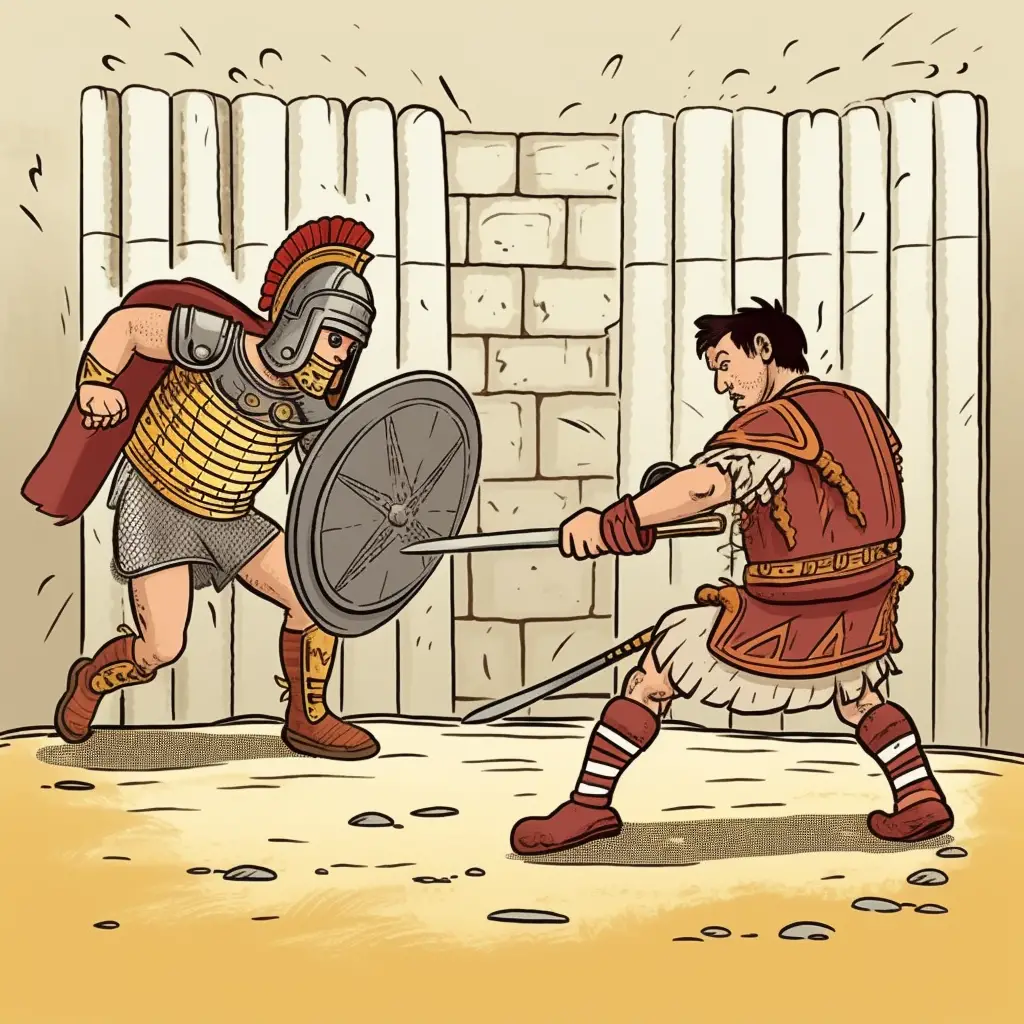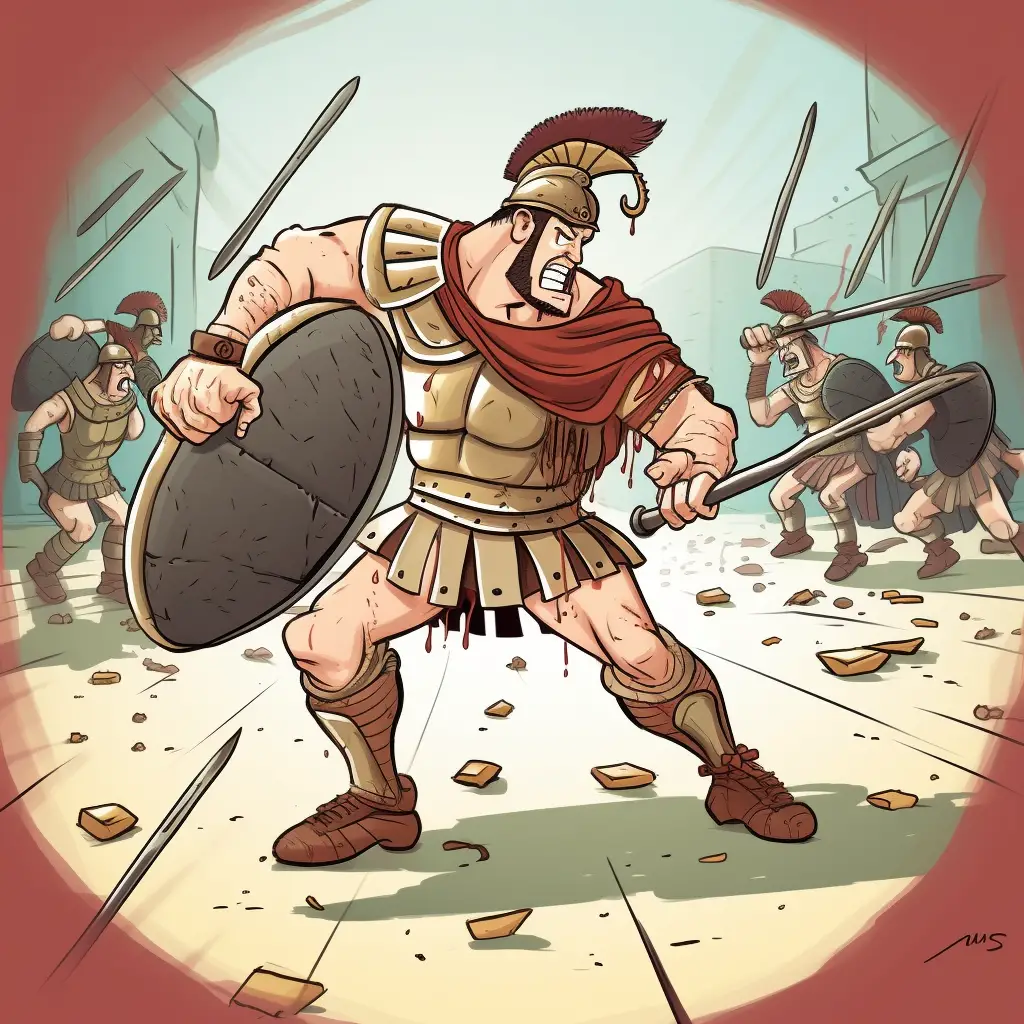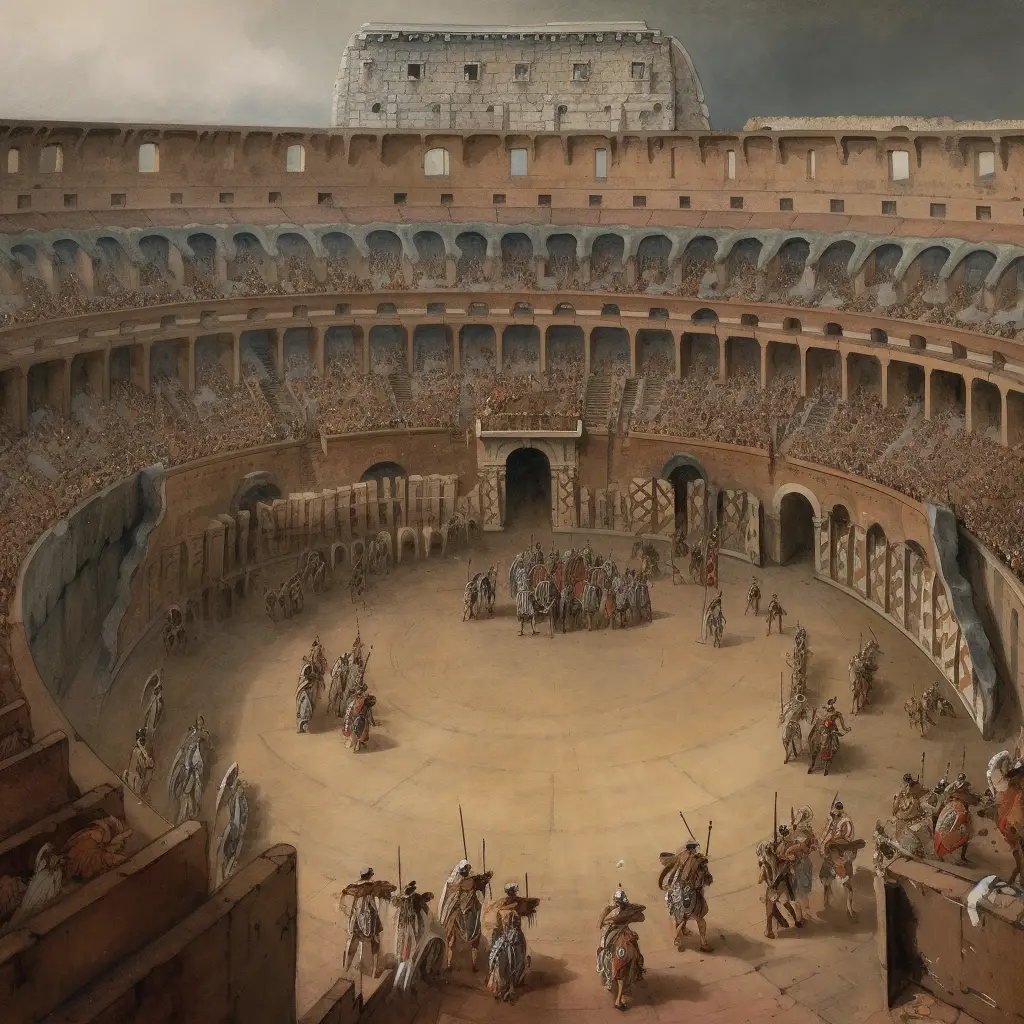Write a short engaging introduction to a web article with the following title Gladiadores romanos – cuento para niños
. Write the content in Spanish.
gladiadores romanos
Los gladiadores eran luchadores que luchaban entre sí y juzgaban a criminales y animales salvajes durante los períodos de la República Romana y el Imperio Romano. Estaban armados con armas mortales y en la mayoría de los casos lucharon hasta que uno de ellos aceptó la derrota o murió en batalla.
Los gladiadores romanos eran luchadores entrenados que entretenían al público con peleas entre ellos o con animales salvajes. A menudo eran esclavos o prisioneros de guerra que tenían que luchar por sus vidas. La popularidad de los juegos de gladiadores alcanzó su punto máximo en el Imperio Romano en los siglos I y II d.C., pero finalmente disminuyó debido al cambio de actitudes hacia la violencia y los costos de mantenimiento de los juegos.
Los gladiadores lucharon para entretener a los ricos y poderosos de Roma, así como al público. La gente se agolpaba en las arenas para ver los juegos de gladiadores, y puede parecer horrible para una persona moderna, pero las peleas de gladiadores eran un deporte popular en Roma, al igual que lo es el fútbol hoy.
Los romanos disfrutaban de la vista de la sangre y el derramamiento de sangre. Construyeron anfiteatros como el “Coliseo”, donde regularmente se celebraban juegos de gladiadores, con multitudes entusiastas animando a sus luchadores favoritos, tal como animamos hoy a nuestros atletas y equipos favoritos.
Datos sobre gladiadores romanos para niños
- Los gladiadores luchaban por entretenimiento.
- Llevaban armaduras y usaban armas.
- Algunos gladiadores eran esclavos.
- Fueron educados en escuelas especiales.
- Los gladiadores luchaban en arenas.
- El emperador observó los combates.
- Los gladiadores tenían diferentes estilos de lucha.
- Lucharon contra otros gladiadores.
- El ganador podría ganarse la libertad.
- Los romanos admiraban a los gladiadores.
El auge y el impacto de los juegos de gladiadores en la antigua Roma
Si bien los historiadores no están del todo seguros de cuándo se originaron los juegos de gladiadores, en general se cree que aparecieron por primera vez a finales del siglo IV a.E.C. se llevaron a cabo.
Muchos creen que el deporte era en realidad una importación extranjera, probablemente etrusca. Los primeros juegos de gladiadores formaban parte de las celebraciones de la victoria en la guerra. Ganaron popularidad y fueron populares en el siglo III a.C. El pasatiempo público más popular.
Los juegos pronto se convirtieron en un ritual y parte de un servicio conmemorativo (munus) celebrado en honor de una persona fallecida y organizado por sus descendientes.
Importancia de los juegos de gladiadores en la sociedad romana: Los juegos de gladiadores no sólo servían para entretener a la gente, sino que también eran utilizados por los patrocinadores para ganarse el favor político. Los propietarios de gladiadores y patrocinadores de estos juegos organizaban extravagantes luchas de gladiadores en honor de los ciudadanos fallecidos para ganarse el favor de sus descendientes poderosos y ricos.
En los años 65 y 63 a.C. En el año 200 a. C., el Senado aprobó leyes anticorrupción para frenar la práctica de ganar favor político mediante juegos de gladiadores. El esfuerzo, sin embargo; no fue exitoso.
Juegos de gladiadores: popularidad y política en la antigua Roma
Los juegos de gladiadores alcanzaron la cima de su popularidad en los últimos días de la República Romana. Julio César desperdició mucho dinero jugando juegos como este.
Durante este período, estos juegos representaron el entretenimiento más popular y asequible para el público y fueron un método útil para ganar apoyo durante los períodos electorales. Los romanos que buscaban patrocinio político utilizaban las luchas de gladiadores como medio para complacer a senadores y cónsules poderosos.
La decadencia de los gladiadores: guerras, religión y el fin de una era
En>
El ascenso del cristianismo como religión oficial del Imperio Romano llevó a la prohibición de todos los rituales y festivales paganos como Munus. Con la disminución del patrocinio oficial, las luchas de gladiadores dejaron de realizarse gradualmente.
Gladiadores: orígenes, diversidad y gloria en la antigua Roma
Los gladiadores fueron reclutados de diversas fuentes. Algunos eran esclavos comprados en varios países bajo control romano, algunos eran prisioneros de guerra y la mayoría eran voluntarios, que en un momento constituyeron la mitad de todos los gladiadores.
A estos combatientes voluntarios se les pagaba por sus servicios y, en general, eran combatientes experimentados. La mayoría de los gladiadores eran tracios, galos y africanos. Hay evidencia de que las mujeres también participaban en deportes de gladiadores. Curiosamente, algunos emperadores como Calígula, Cómodo, Tito y Claudio también participaron en estos deportes. Sin embargo, las batallas entre emperadores deberían suponer un riesgo mínimo para ellos.
La etnia de los gladiadores también era evidente en la forma en que iban vestidos y armados. Los gladiadores usaban espadas, lanzas, lanzas cortas y escudos como armas y usaban cascos y chalecos antibalas para protección. Sus dueños los alimentaban y cuidaban bien y los recompensaban después de ganar batallas.
El público también admiraba a los gladiadores famosos y exitosos y respetaba a aquellos que murieron valientemente en la arena.
Coliseo Romano
El>
Estas notables actuaciones demostraron la habilidad, el coraje y la resistencia de estos guerreros mientras luchaban ferozmente por sus vidas. El Coliseo se convirtió en un símbolo del esplendor y la magnificencia de los juegos de gladiadores romanos, dejando una huella indeleble en los anales y la imaginación de estos luchadores legendarios.
Write an SEO optimized article for a blog, with frequently asked questions. About the following topic Gladiadores romanos – cuento para niños
. Get inspired by the following content,
HomeEgyptMiddle AgesGreeceRomeAsiaChinaAmericanQuizWorksheetsLessons
Roman GladiatorsPlease enable JavaScriptRoman Daily Life
ShareWatch onGladiators were combatants who fought against each other and condemned criminals and wild animals during the time of the Roman Republic and Roman Empire. They were armed with deadly weapons and in most cases fought till either one of them accepted defeat or was killed fighting.Roman gladiators were trained fighters who entertained audiences by engaging in battles with each other or with wild animals. They were often slaves or prisoners of war who were forced to fight for their lives. The popularity of gladiatorial games peaked in the Roman Empire during the 1st and 2nd centuries AD but eventually declined due to changing attitudes towards violence and the cost of maintaining the games.Gladiators fought for the entertainment of Rome’s rich and mighty and also for the public. People thronged the arenas to watch gladiator games and it may sound appalling to a modern man, but gladiator fighting was a popular sport in Rome, just like soccer is today.Roman people enjoyed the sight of blood and carnage. They built amphitheaters like ‘The Colosseum’, where gladiator games were held regularly and were witnessed by excited crowds who cheered for their favorite fighters just like we cheer for our favorite sportsmen and teams today.Roman Gladiators Facts for KidsGladiators fought for entertainment.They wore armor and used weapons.Some gladiators were slaves.They trained in special schools.Gladiators fought in arenas.The emperor watched the fights.Gladiators had different fighting styles.They fought against other gladiators.The winner could earn freedom.Gladiators were admired by Romans.The Rise and Impact of Gladiator Games in Ancient RomeWhile historians are not really sure about the exact time of origin of gladiator games, it is widely believed that they were first held in the late fourth century BC.Many believe that the sport was in fact, a foreign import, most probably Etruscan. The early gladiator games were a part of war victory celebrations. They gained popularity and by the third century BC, were the most popular public pastime.The games soon became a ritual and a part of a commemorative service (Munus) offered in honor of a dead individual, arranged by his descendants.Importance of Gladiator Games in Roman Society: Gladiator games were not only a source of entertainment for people but were also used by sponsors to gain political favors. Gladiator owners and sponsors of such games arranged extravagant gladiator fights in honor of dead citizens to gain favors from their powerful and rich descendants.In 65 and 63 BC, anti-corruption laws were passed by the Senate to curb the custom of gaining political favors through gladiator games. The effort, however; did not succeed.Gladiator Games: Popularity and Politics in Ancient RomeGladiator games reached the peak of their popularity in the last days of the Roman Republic. Julius Caesar splurged a huge amount of wealth on such games.During this period, these games provided the most popular and cheap entertainment to the public and were a useful method of garnering support during election times. Romans seeking political patronage used gladiator fights as a tool to please powerful senators and consuls.Decline of Gladiators: Wars, Religion, and the End of an EraIn the third century AD, Roman Empire faced existential challenges. This meant more spending on wars and less on gladiatorial games and rituals.The rise of Christianity as the official religion of the Roman Empire resulted in the banning of all pagan rituals and festivals like Munus. With a decline in official patronage, gladiator fights gradually ceased to take place.Gladiators: Origins, Diversity, and Fame in Ancient RomeGladiators were recruited from different sources. Some were slaves bought from different lands under Roman control, some were prisoners of war and most of the others were volunteers who at a time accounted for half of all the gladiators.These volunteer combatants were paid for their services and were generally skilled fighters. Most of the gladiators were Thracians, Gauls, and Africans. There is evidence to suggest that females also participated in gladiatorial sports. Interestingly certain emperors like Caligula, Commodus, Titus, and Claudius also participated in such sports. However, the fights involving emperors were designed to pose minimal risk to them.The ethnicity of gladiators was also evident from the way they were dressed and armed. Gladiators used swords, spears, short javelins, and shields as weapons and wore helmets and body armor for protection. They were well fed and looked after by their owners and were rewarded after they won fights.The Public also admired famous and successful gladiators and respected those who died courageously in the arena.Roman ColosseumThe Roman Colosseum, known as the Flavian Amphitheatre, held immense significance in the history of Roman gladiators. Constructed in the first century AD, this majestic arena hosted gladiatorial combats and captivating spectacles. With its vast capacity, it drew in crowds of tens of thousands, eagerly assembled to witness the exhilarating clashes between gladiators.These remarkable displays exhibited the skill, bravery, and endurance of these warriors, who fought fiercely for their lives. The Colosseum became an emblem of the splendor and magnificence of Roman gladiatorial games, etching an indelible mark on the annals and imagination of these legendary combatants.
Ancient Rome ColoringAncient Rome QuizzesAncient Rome Worksheets
Ancient EgyptAncient RomeAncient GreeceAmerican HistoryAsian Middle AgesChinaAboutSite Map© 2024 History for Kids. All rights reserved.
. Complement this information with additional information. Write this article in html format for a web page, with
,
, , ,
,
- tags. Remove
tags. Add external reference links to relevant sources within the text. Writing Style: Academic. Writing Tone: Narrative. Write the content in Spanish.
- ,
- tags. Remove
tags. Add external reference links to relevant sources within the text. Writing Style: Academic. Writing Tone: Narrative. Write the content in Spanish.


